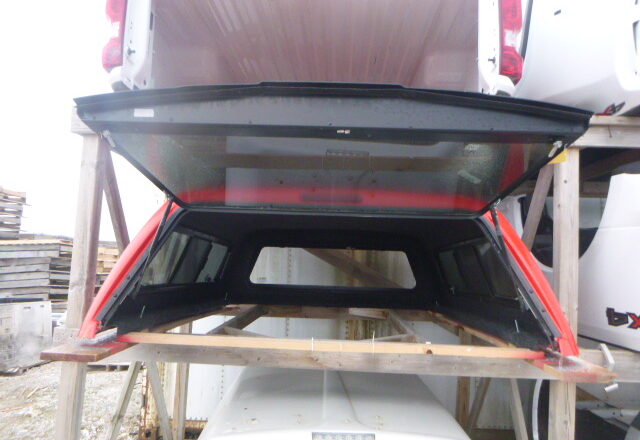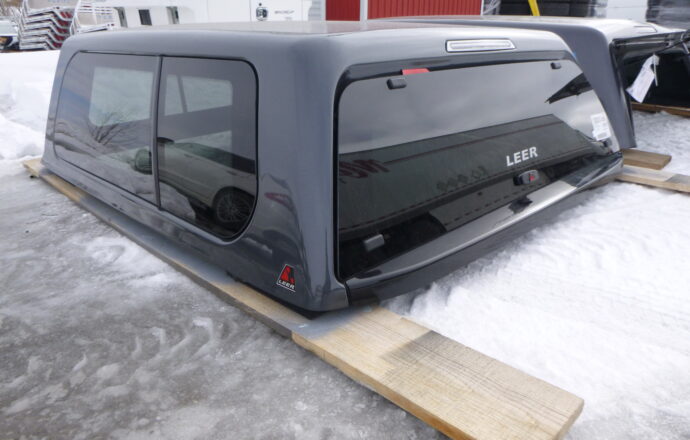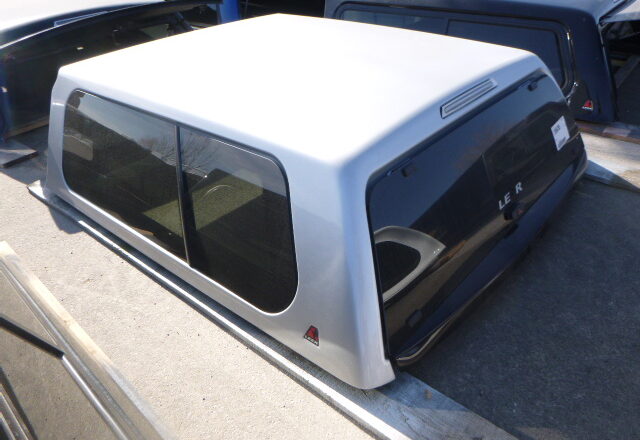The Perfect Fit: Understanding the Intricacies of Truck Cap Size types.truckstrend.com
A truck cap, also known as a truck topper, camper shell, or bed cap, transforms the open bed of a pickup truck into a secure, weather-protected, and highly versatile storage or living space. Far from being a one-size-fits-all accessory, the size of truck caps is perhaps the single most critical factor determining compatibility, functionality, and overall satisfaction. An ill-fitting cap can lead to leaks, security vulnerabilities, compromised aesthetics, and even potential damage to your truck. Understanding the precise dimensions and specific requirements is paramount to making an informed decision, ensuring your investment enhances, rather than hinders, your truck’s utility.
This comprehensive guide will delve into every aspect of truck cap sizing, from the fundamental measurements to the subtle nuances that dictate a perfect fit. Whether you’re a contractor needing secure tool storage, an outdoor enthusiast seeking shelter for gear, or simply looking to expand your truck’s carrying capacity, knowing your cap size is the first, most vital step.
The Perfect Fit: Understanding the Intricacies of Truck Cap Size
Decoding Truck Bed Dimensions: The Blueprint for Your Cap
At the core of truck cap sizing lies the precise dimensions of your truck’s bed. Unlike some accessories that offer universal fitment, truck caps are highly specific, designed to conform to the unique contours and dimensions of particular truck makes, models, and even model years.
-
Bed Length: This is the most obvious and commonly referenced dimension. Truck beds typically come in three general lengths:
- Short Bed: Often around 5.5 feet (e.g., 66 inches), common on crew cab trucks.
- Standard/Regular Bed: Usually around 6.5 feet (e.g., 78-79 inches), a versatile option for various cab configurations.
- Long Bed: Typically 8 feet (e.g., 96-98 inches), primarily found on regular cab or extended cab work trucks, offering maximum cargo space.
- Important Note: While these are general categories, the exact measurement can vary by an inch or two between manufacturers (e.g., a "6.5-foot bed" on a Ford might be 78.9 inches, while on a Chevy it’s 79.2 inches). These small differences are critical for a snug fit.


Bed Width: Truck beds are not uniform in width along their entire length. The width can vary slightly from the bulkhead (the wall closest to the cab) to the tailgate. More importantly, the width across the top bed rails where the cap will sit is crucial. This measurement also varies significantly between different truck models and even generations of the same model. A cap designed for an F-150 will not fit a Silverado, even if both have 6.5-foot beds, due to differences in bed rail width and curvature.
-
Bed Rail Contours and Tailgate Shape: This is where the highly specific nature of truck caps truly comes into play. The top edge of your truck’s bed rails isn’t perfectly flat or straight. It often has subtle curves, dips, or raised sections, especially near the cab and tailgate. The cap’s base rails must perfectly match these contours to create a weather-tight seal and a visually integrated appearance. Similarly, the design of the cap’s rear door must precisely align with your truck’s tailgate to ensure proper closure and security.
-
Cab Style: While not a direct measurement for the cap itself, your truck’s cab style (Regular Cab, Extended Cab/Access Cab/Quad Cab, Crew Cab/Double Cab) often dictates the bed length available and, consequently, the range of cap sizes you can choose from. It also influences the overall aesthetic balance of the truck with a cap installed.

Navigating Cap Styles: Height and Design Considerations
Beyond the fundamental bed dimensions, truck caps come in various heights and designs, each offering different benefits related to cargo volume and aesthetics. Understanding these variations helps you select the right "size" in terms of utility.
- Cab-High Caps: These are the most popular choice. As the name suggests, their roof line matches the height of your truck’s cab, creating a sleek, integrated, and aerodynamic profile. They offer excellent weather protection and security for general cargo and are often preferred for their minimal impact on fuel economy and visual appeal.
- Mid-Rise Caps: Slightly taller than cab-high, mid-rise caps typically add 2-6 inches of additional interior height. This extra vertical space can be invaluable for carrying taller items, providing more comfortable standing room for camping, or accommodating bulkier gear that wouldn’t fit in a cab-high cap. They offer a good balance between increased utility and maintaining a relatively low profile.
- High-Rise/Commercial Caps: These caps are significantly taller, often featuring a raised roof that provides maximum cargo volume. They are commonly seen on work trucks for contractors, electricians, or plumbers, offering ample space for tools, equipment, and even interior shelving systems. For recreational users, they are ideal for serious camping, overlanding, or transporting large, bulky items. Their taller profile can affect aerodynamics and aesthetics.
- Wedge/Slanted Caps: These caps are typically cab-high at the front and gradually rise towards the rear, creating a sloped appearance. They offer increased rear cargo volume without the full height of a high-rise cap, and their unique design is often chosen for aesthetic reasons or to accommodate specific gear that benefits from the rear height.
- Custom/Specialty Caps: Some manufacturers offer highly customized solutions, such as caps designed for specific overlanding setups, or those with unique access points, reinforced roofs for roof-top tents, or integrated storage systems. These are tailored to very specific needs and often come at a premium.
Precision Measuring: Your Step-by-Step Guide to a Perfect Fit
While reputable truck cap dealers will often verify fitment using their databases, knowing how to measure your truck bed yourself is invaluable for research, online purchases, or checking used caps.
- Measure Bed Length: Use a tape measure to get the inside length of your truck bed. Measure from the front bulkhead (the wall closest to the cab) to the inside edge of the tailgate. Measure along the top of the bed rails. Repeat this measurement several times to ensure accuracy.
- Measure Bed Width (Front): Measure the width across the top of your bed rails near the bulkhead, closest to the cab.
- Measure Bed Width (Rear): Measure the width across the top of your bed rails near the tailgate. You might find a slight difference.
- Note Bed Rail Height/Contour: Observe the shape of your bed rails. Are they perfectly flat? Do they have a slight curve or raised lip? Note any accessories like bed rail caps, drop-in bed liners, or spray-in liners, as these can slightly alter dimensions or affect the cap’s seal.
- Identify Your Truck: Crucially, write down your truck’s exact year, make, model, and trim level. For example: "2020 Ford F-150 SuperCrew with a 5.5-foot bed." This information, combined with your measurements, is what cap manufacturers use for precise fitment.
Beyond Dimensions: The Benefits of a Proper Fit
The importance of a perfectly sized truck cap extends far beyond mere compatibility. A proper fit ensures optimal performance and satisfaction:
- Weather Sealing: A cap that perfectly matches your truck’s bed rails will create a tight, impermeable seal, preventing rain, snow, and dust from entering your cargo area. An ill-fitting cap is an open invitation for water damage and dirty gear.
- Security: When a cap fits snugly, it’s much harder to pry open or compromise. Gaps or misalignments can be weak points that a determined thief could exploit.
- Aerodynamics & Fuel Economy: A well-fitted, especially cab-high, cap can actually improve your truck’s aerodynamics by smoothing airflow over the bed, potentially leading to a marginal improvement in fuel economy compared to an open bed. A poorly fitting or overly tall cap, conversely, can increase drag.
- Aesthetics: A cap that looks like it was custom-made for your truck enhances its overall appearance. A mismatched cap, with visible gaps or an awkward profile, detracts from your truck’s look.
- Safety: A securely mounted cap won’t shift, rattle, or, in extreme cases, detach while driving, ensuring the safety of your cargo and other road users.
Making the Right Choice: Factors Influencing Your Decision
Choosing the right truck cap size isn’t just about what fits, but also about what serves your needs.
- Intended Use: Are you protecting groceries from rain, hauling expensive tools, or planning multi-day camping trips? Your primary use will dictate the necessary height and features.
- Cargo Volume Needs: How much space do you truly need? Consider the tallest, widest, and longest items you plan to transport regularly. Don’t just think about volume; think about accessibility (e.g., side access windows for tools).
- Budget: Generally, larger caps, those with more features (e.g., interior lighting, carpeted headliners, power locks), and those made from premium materials (e.g., high-quality fiberglass) will cost more.
- Vehicle Aesthetics: Do you prefer a sleek, integrated look (cab-high) or are you willing to sacrifice some aerodynamics for maximum utility (high-rise)?
- Future Plans: Consider if your needs might change. If you plan to get a taller camper or add a roof rack for kayaks, a mid-rise or high-rise might be a better long-term investment.
Common Challenges and Smart Solutions
Even with careful planning, some challenges can arise when dealing with truck cap sizes:
- Finding a Cap for Older or Uncommon Trucks: Manufacturers discontinue cap lines, making it harder to find new caps for older models.
- Solution: Explore the used market (Craigslist, Facebook Marketplace, specialty forums), but be extra cautious with measurements. Some custom fabricators might be able to build one, but at a significant cost.
- Mismatch Issues (Bought Wrong Size): Accidentally purchasing a cap that doesn’t fit your truck.
- Solution: Immediately contact the seller or manufacturer. If it’s a used cap, your options are limited to reselling it yourself. Modifications are rarely cost-effective or successful for significant fit issues.
- Bed Liners and Accessories Impacting Fit: Drop-in bed liners, thick bed rail caps, or existing toolboxes can interfere with a cap’s proper seating or sealing.
- Solution: Inform the cap dealer about all existing accessories. You may need to remove, trim, or modify certain accessories for the cap to sit correctly. Spray-in liners generally do not affect fit.
- Weight Distribution: Larger, heavier caps can add significant weight to your truck’s rear, potentially affecting handling, fuel economy, and payload capacity.
- Solution: Be aware of the cap’s weight (manufacturers usually provide this) and your truck’s payload capacity. Consider suspension upgrades if you frequently carry heavy loads in the cap.
Price Table: Estimated Costs for Truck Caps by Size and Type
Please note that these are estimated price ranges and can vary significantly based on brand, material (fiberglass is generally more expensive than aluminum), features (windows, lighting, carpet, racks, remote locks), dealer location, installation costs, and current market conditions. This table provides a general guide.
| Cap Type/Height | Truck Bed Length (Approx.) | Material Type | Key Features (Common) | Estimated Price Range (USD) |
|---|---|---|---|---|
| Cab-High | 5.5 ft (Short Bed) | Fiberglass / Aluminum | Side windows, rear door, interior light, basic lock | $1,500 – $3,000 |
| Cab-High | 6.5 ft (Standard Bed) | Fiberglass / Aluminum | Side windows, rear door, interior light, basic lock | $1,600 – $3,200 |
| Cab-High | 8 ft (Long Bed) | Fiberglass / Aluminum | Side windows, rear door, interior light, basic lock | $1,700 – $3,500 |
| Mid-Rise | 5.5 ft (Short Bed) | Fiberglass / Aluminum | Taller roof, side windows, rear door, interior light | $1,800 – $3,500 |
| Mid-Rise | 6.5 ft (Standard Bed) | Fiberglass / Aluminum | Taller roof, side windows, rear door, interior light | $1,900 – $3,700 |
| Mid-Rise | 8 ft (Long Bed) | Fiberglass / Aluminum | Taller roof, side windows, rear door, interior light | $2,000 – $4,000 |
| High-Rise / Commercial | Any Bed Length | Fiberglass / Aluminum | Max height, often solid sides or commercial doors | $2,200 – $5,000+ |
| Specialty / Custom | Any Bed Length | Fiberglass / Aluminum | Reinforced roof, custom openings, specific designs | $3,500 – $7,000+ |
Note: Installation costs (typically $100-$300) are usually separate from the cap price.
Frequently Asked Questions (FAQ)
Q: Can I use a truck cap from a different make/model of truck?
A: Rarely. Truck caps are highly specific to the exact year, make, and model of your truck. Even if bed lengths seem similar, subtle differences in bed rail width, curvature, and tailgate design will prevent a proper, weather-tight, and secure fit.
Q: Do truck caps come in universal sizes?
A: No. While some manufacturers might offer "universal fit" clamps or accessories, the cap shell itself is never universal. It must be specifically designed for your truck’s bed dimensions and contours.
Q: How do I accurately measure my truck bed for a cap?
A: Measure the inside length of your truck bed from the bulkhead (front) to the tailgate. Also, measure the width across the top of the bed rails at both the front and rear. Most importantly, have your truck’s exact year, make, model, and cab style ready when speaking to a cap dealer.
Q: What’s the main difference between a cab-high and a mid-rise cap?
A: A cab-high cap matches the height of your truck’s cab for a sleek look and better aerodynamics. A mid-rise cap is typically 2-6 inches taller than the cab, offering more interior cargo volume, which is beneficial for taller items or more comfortable camping.
Q: Will adding a truck cap affect my gas mileage?
A: The impact varies. A well-fitted, cab-high cap can sometimes slightly improve or have a negligible effect on fuel economy by reducing drag compared to an open bed. Taller or poorly fitted caps, however, can increase aerodynamic drag and slightly decrease fuel efficiency.
Q: How much does a truck cap typically weigh?
A: The weight depends on the material, size, and features. Fiberglass caps can range from 150 lbs to 250 lbs or more for larger, feature-rich models. Aluminum caps are generally lighter, often ranging from 100 lbs to 200 lbs.
Q: Can I install a truck cap myself?
A: Yes, it is possible to install a truck cap yourself, especially with assistance. Most caps come with clamps that secure them to the bed rails. However, professional installation ensures proper sealing, electrical connections for lights (if applicable), and correct alignment, which is highly recommended for optimal performance and longevity.
Conclusion
The "size of truck caps" is not merely a measurement; it’s a precise alignment of form and function. From the foundational dimensions of your truck bed to the subtle nuances of bed rail contours and the strategic choice of cap height, every aspect plays a critical role in achieving the perfect fit. Taking the time to accurately measure, understand the different cap styles, and consider your specific needs will lead to an investment that enhances your truck’s utility, provides secure and weather-protected storage, and seamlessly integrates with your vehicle’s aesthetics. Choose wisely, and your truck cap will become an indispensable extension of your pickup, ready for any adventure or task you throw its way.
